tire pressure MERCEDES-BENZ SPRINTER 2017 MY17 Operator’s Manual
[x] Cancel search | Manufacturer: MERCEDES-BENZ, Model Year: 2017, Model line: SPRINTER, Model: MERCEDES-BENZ SPRINTER 2017Pages: 286, PDF Size: 4.36 MB
Page 5 of 286

Indicator and warning lamps in the
instrument cluster ............................... 190
Stowing and features.......................200
Useful information ............................... 200
Stowage spaces and stowage com-
partments ............................................ 200
Cup holder ........................................... 204
Bottle holder ........................................ 204
Ashtray ................................................ 205
Cigarette lighter ................................... 205
12 V socket .........................................2 06
Mobile phone ....................................... 206
Additional communications equip-
ment .................................................... 207
Transporting loads ............................208
Useful information ............................... 208
Loading guidelines ............................... 208
Load distribution ................................. 210
Securing loads ..................................... 210
Carrier systems ................................... 212
Maintenance and care ......................214
Useful information ............................... 214
Engine compartment ........................... 214
Vehicle interior ....................................2 21
Maintenance ........................................ 221
Battery ................................................. 223
Care ..................................................... 229
Breakdown assistance .....................236
Useful information ............................... 236
Where will I find...? .............................. 236
Flat tire ................................................ 238
Jump-starting ....................................... 238
Tow-starting and towing away ............. 239
Electrical fuses ....................................2 42
Wheels and tires............................... 243
Useful information ............................... 243
Important safety notes ........................ 243
Operation ............................................ 243
Operation in winter .............................. 245
Tire pressure ....................................... 246 Loading the vehicle .............................. 254
What you should know about wheels
and tires .............................................. 257
Flat tire ................................................ 262
Changing wheels ................................. 262
Wheel and tire combination ................. 268
Spare wheel ......................................... 268
Technical data
................................... 271
Useful information ............................... 271
Vehicle electronics .............................. 271
Identification plates .............................2 72
Service products and capacities .......... 273
Vehicle data ......................................... 281
Contents3
Page 6 of 286
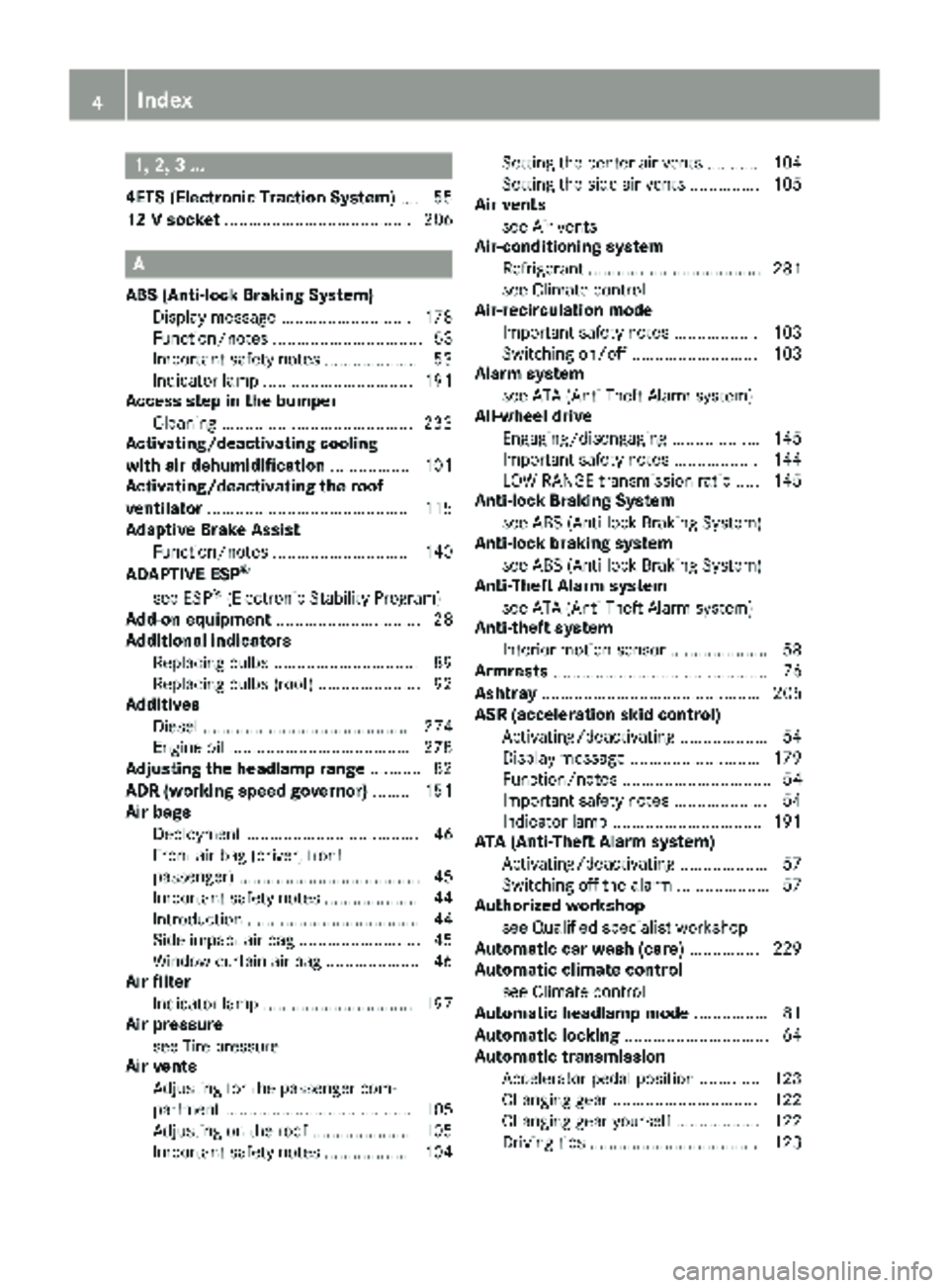
1, 2, 3 ...
4ETS (Electronic Traction System).... 55
12 V socket ........................................ 206
A
ABS (Anti-lock Braking System)
Display message ............................ 178
Function/notes ................................ 53
Important safety notes .................... 53
Indicator lamp ................................ 191
Access step in the bumper
Cleaning .........................................2 33
Activating/deactivating cooling
with air dehumidification ................. 101
Activating/deactivating the roof
ventilator ...........................................1 15
Adaptive Brake Assist
Function/notes .............................1 40
ADAPTIVE ESP
®
see ESP®(Electronic Stability Program)
Add-on equipment ............................... 28
Additional indicators
Replacing bulbs ............................... 89
Replacing bulbs (roof) ......................9 2
Additives
Diesel ............................................ 274
Engine oil ...................................... .278
Adjusting the headlamp range ........... 82
ADR (working speed governor) ........151
Air bags
Deployment ..................................... 46
Front air bag (driver, front
passenger) ....................................... 45
Important safety notes .................... 44
Introduction ..................................... 44
Side impact air bag .......................... 45
Window curtain air bag .................... 46
Air filter
Indicator lamp ................................ 197
Air pressure
see Tire pressure
Air vents
Adjusting for the passenger com-
partment ........................................ 105
Adjusting on the roof ..................... 105
Importa nt sa
fety notes .................. 104 Setting the center air vents ........... 104
Setting the side air vents ...............1
05
Air vents
see Air vents
Air-conditioning system
Refrigerant ..................................... 281
see Climate control
Air-recirculation mode
Important safety notes .................. 103
Switching on/off ........................... 103
Alarm system
see ATA (Anti-Theft Alarm system)
All-wheel drive
Engaging/disengaging ................... 145
Important safety notes .................. 144
LOW RANGE transmission ratio ..... 145
Anti-lock Braking System
see ABS (Anti-lock Braking System)
Anti-lock braking system
see ABS (Anti-lock Braking System)
Anti-Theft Alarm system
see ATA (Anti-Theft Alarm system)
Anti-theft system
Interior motion sensor ..................... 58
Armrests .............................................. 76
Ashtray ............................................... 205
ASR (acceleration skid control)
Activating/deactivating ................... 54
Display message ............................ 179
Function/notes ................................ 54
Important safety notes .................... 54
Indicator lamp ................................ 191
ATA (Anti-Theft Alarm system)
Activating/deactivating ................... 57
Switching off the alarm .................... 57
Authorized workshop
see Qualified specialist workshop
Automatic car wash (care) ...............229
Automatic climate control
see Climate control
Automatic headlamp mode ................ 81
Automatic locking ............................... 64
Automatic transmission
Accelerator pedal position ............. 123
Changing gear ............................... 122
Changing gear yourself .................. 122
Driving tips .................................... 123
4Index
Page 21 of 286
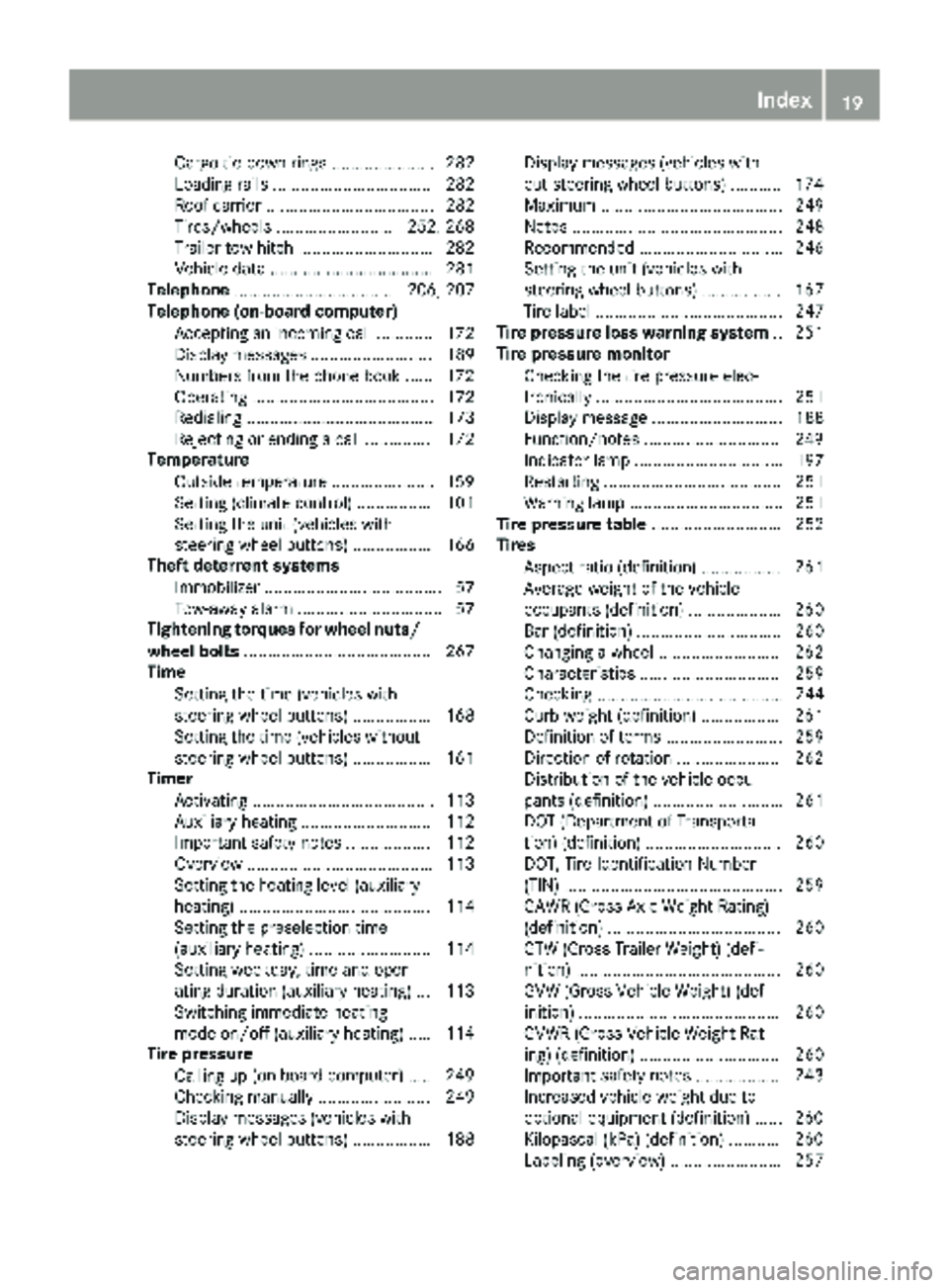
Cargo tie-down rings ...................... 282
Loading rails .................................. 282
Roof carrier .................................... 282
Tires/wheels........................ .252, 268
Trailer tow hitch .............................2 82
Vehicle data ................................... 281
Telephone .................................. 206, 207
Telephone (on-board computer)
Accepting an incoming call ............ 172
Display messages .......................... 189
Numbers from the phone book ...... 172
Operating ....................................... 172
Redialing ........................................ 173
Rejecting or ending a call .............. 172
Temperature
Outside temperature ......................1 59
Setting (climate control) ................ 101
Setting the unit (vehicles with
steering wheel buttons) ................. 166
Theft deterrent systems
Immobilizer ...................................... 57
Tow-away alarm ............................... 57
Tightening torques for wheel nuts/
wheel bolts ........................................ 267
Time
Setting the time (vehicles with
steering wheel buttons) ................. 168
Setting the time (vehicles without
steering wheel buttons) ................. 161
Timer
Activating ....................................... 113
Auxiliary heating ............................ 112
Important safety notes .................. 112
Overview ........................................ 113
Setting the heating level (auxiliary
heating) ......................................... 114
Setting the preselection time
(auxiliary heating) .......................... 114
Setting weekday, time and oper-
ating duration (auxiliary heating) ... 113
Switching immediate heating
mode on/off (auxiliary heating) ..... 114
Tire pressure
Calling up (on-board computer) ..... 249
C
hecking manually ........................ 249
Display messages (vehicles with
steering wheel buttons) ................. 188 Display messages (vehicles with-
out steering wheel buttons) ........... 174
Maximum ....................................... 249
Notes ............................................. 248
Recommended ............................... 246
Setting the unit (vehicles with
steering wheel buttons) ................. 167
Tire label ........................................ 247
Tire pressure loss warning system .. 251
Tire pressure monitor
Checking the tire pressure elec-
tronically ........................................ 251
Display message ............................ 188
Function/notes .............................2 49
Indicator lamp ................................ 197
Restarting ...................................... 251
Warning lamp ................................. 251
Tire pressure table ............................ 252
Tires
Aspect ratio (definition) ................. 261
Average weight of the vehicle
occupants (definition) .................... 260
Bar (definition) ............................... 260
Changing a wheel .......................... 262
Characteristics .............................. 259
Checking ........................................ 244
Curb weight (definition) ................. 261
Definition of terms ......................... 259
Direction of rotation ...................... 262
Distribution of the vehicle occu-
pants (definition) ............................ 261
DOT (Department of Transporta-
tion) (definition) ............................. 260
DOT, Tire Identification Number
(TIN) ............................................... 259
GAWR (Gross Axle Weight Rating)
(definition) ..................................... 260
GTW (Gross Trailer Weight) (defi-
nition) ............................................ 260
GVW (Gross Vehicle Weight) (def-
inition) ........................................... 260
GVWR (Gross Vehicle Weight Rat-
ing) (definition) .............................. 260
Important safety notes .................. 243
Increased vehicle weight due to
optional equipment (definition) ...... 260
Kilopascal (kPa) (definition) ........... 260
Labeling (overview) ........................ 257
Index19
Page 22 of 286

Load bearing index (definition) ...... 261
Load index .....................................258
Load index (definition) ................... 260
M+S tires ....................................... 245
Maximum load on a tire (defini-
tion) ............................................... 261
Maximum loaded vehicle weight
(definition) ..................................... 260
Maximum permissible tire pres-
sure (definition) .............................2 61
Maximum tire load ......................... 259
Maximum tire load (definition) ....... 261
Optional equipment weight (defi-
nition) ............................................ 261
PSI (pounds per square inch) (def-
inition) ...........................................2 61
Replacing ....................................... 262
Service life ..................................... 244
Sidewall (definition) ....................... 261
Snow chains .................................. 246
Speed rating (definition) ................ 260
Storing ...........................................2 62
Structure and characteristics
(definition) ..................................... 259
Summer tires ................................. 245
TIN (Tire Identification Number)
(definition) ..................................... 261
Tire bead (definition) ......................2 61
Tire pressure (definition) ................ 261
Tire pressures (recommended) ...... 260
Tire size (data) ....................... 252, 268
Tire size designation, load-bearing
capacity, speed rating .................... 257
Tire tread ....................................... 244
Tire tread (definition) ..................... 261
Total load limit (definition) ............. 261
Traction (definition) ....................... 261
TWR (permissible trailer drawbar
noseweight) (definition) ................. 261
Uniform Tire Quality Grading
Standards (definition) .................... 260
Wear indicator (definition) ............. 261
Wheel rim (definition) .................... 260
Top Tether ............................................ 50
To
uchshift (automatic transmis-
sion) .................................................... 122
Tow-away alarm
Arming/deactivating ........................ 57 Deactivating ..................................... 57
Operation ......................................... 57
Tow-starting
Emergency engine starting ............ 242
Important safety notes .................. 239
Towing
If the vehicle is stuck ..................... 241
Installing/removing the towing
eye ................................................. 240
With a raised front or rear axle ...... 241
Towing a trailer
Axle load, permissible .................... 283
Cleaning the trailer tow hitch ......... 233
Coupling up a trailer ......................1 54
Decoupling a trailer ....................... 156
Driving tips ....................................1 52
Important safety notes .................. 152
Notes on retrofitting ......................2 82
Trailer loads ................................... 283
Towing away
Important safety guidelines ........... 239
In the event of malfunctions .......... 240
With both axles on the ground ....... 241
Trailer
Brake force booster malfunction ... 192
Trailer coupling
see Towing a trailer
Trailer loads and drawbar nose-
weights ............................................... 156
Trailer towing
Blind Spot Assist ............................ 143
PARKTRONIC ................................. 150
Permissible trailer loads and
drawbar noseweights ..................... 156
Transmission
see Automatic transmission
Transmission oil ................................ 279
Transport
Loading guidelines ......................... 208
Vehicle ...........................................2 42
Transport by rail ................................ 132
Transportation
Rail ................................................ 132
Transporting
Load distribution ............................ 210
Securing a load .............................. 210
Trim pieces (cleaning instruc-
tions) ..................................................2 34
20Index
Page 24 of 286
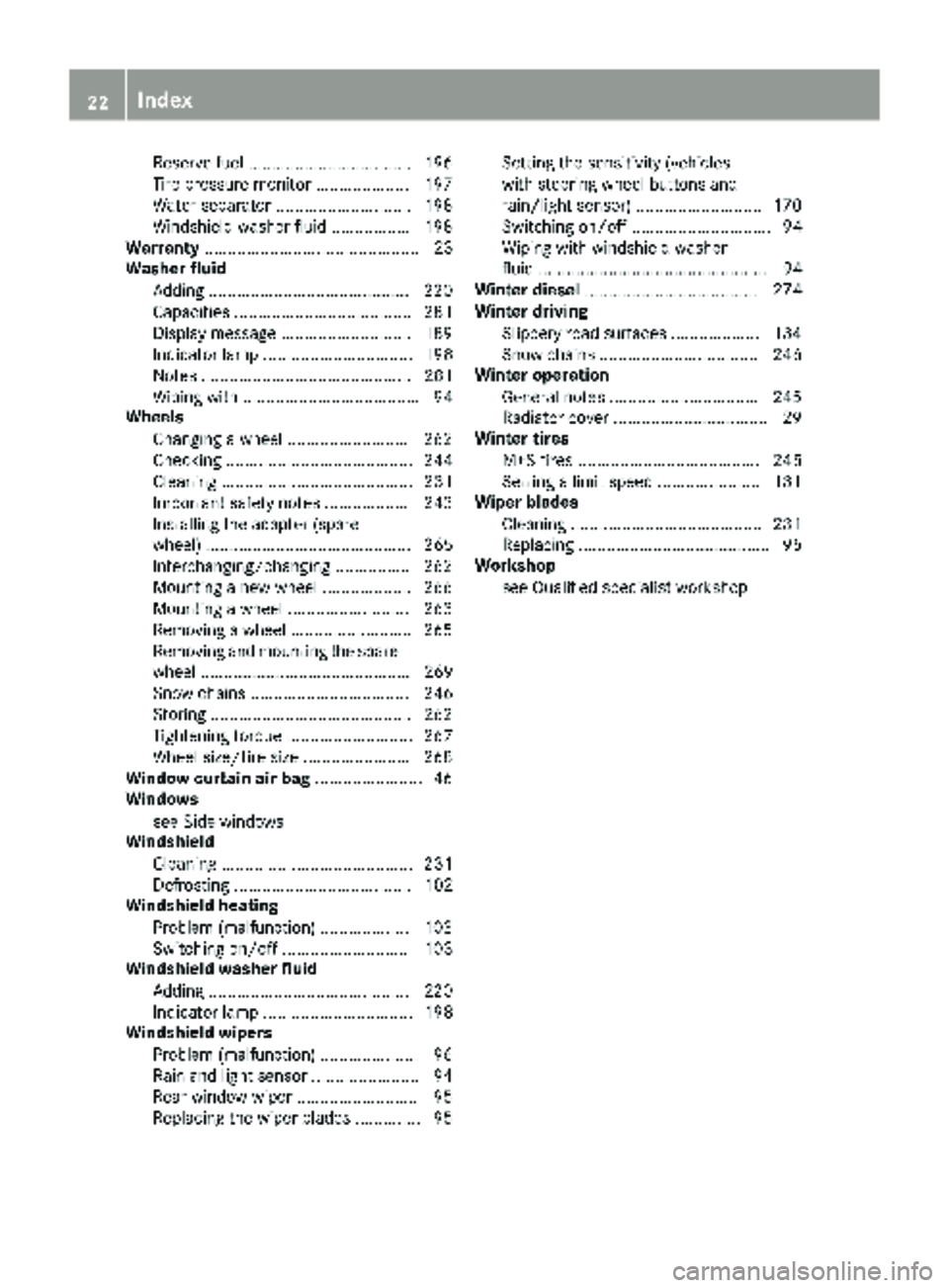
Reservefuel .................................. .196
Tire pressure monitor .................... 197
Water separator .............................1 98
Windshield washer fluid ................. 198
Warranty .............................................. 23
Washer fluid
Adding ...........................................2 20
Capacities ...................................... 281
Display message ............................ 189
Indicator lamp ................................ 198
Notes ............................................. 281
Wiping with ...................................... 94
Wheels
Changing a wheel .......................... 262
Checking ........................................ 244
Cleaning ......................................... 231
Important safety notes .................. 243
Installing the adapter (spare
wheel) ............................................ 265
Interchanging/changing ................ 262
Mounting a new wheel ................... 266
Mounting a wheel .......................... 263
Removing a wheel .......................... 265
Removing and mounting the spare
wheel ............................................. 269
Snow chains .................................. 246
Storing ...........................................2 62
Tightening torque ........................... 267
Wheel size/tire size ....................... 268
Window curtain air bag ....................... 46
Windows
see Side windows
Windshield
Cleaning ......................................... 231
Defrosting ...................................... 102
Windshield heating
Problem (malfunction) ................... 103
Switching on/off ........................... 103
Windshield washer fluid
Adding ...........................................2 20
Indicator lamp ................................ 198
Windshield wipers
Problem (malfunction) ..................... 96
Rain and light sensor ....................... 94
Rear window wiper .......................... 95
Replacing the wiper blades .............. 95 Setting the sensiti
vity (vehicles
with steering wheel buttons and
rain/light sensor) ........................... 170
Switching on/off .............................. 94
Wiping with windshield washer
fluid ................................................. 94
Winter diesel ..................................... 274
Winter driving
Slippery road surfaces ................... 134
Snow chains .................................. 246
Winter operation
General notes ................................ 245
Radiator cover ................................. 29
Winter tires
M+S tires ....................................... 245
Setting a limit speed ......................1 31
Wiper blades
Cleaning ......................................... 231
Replacing ......................................... 95
Workshop
see Qualified specialist workshop
22Index
Page 28 of 286
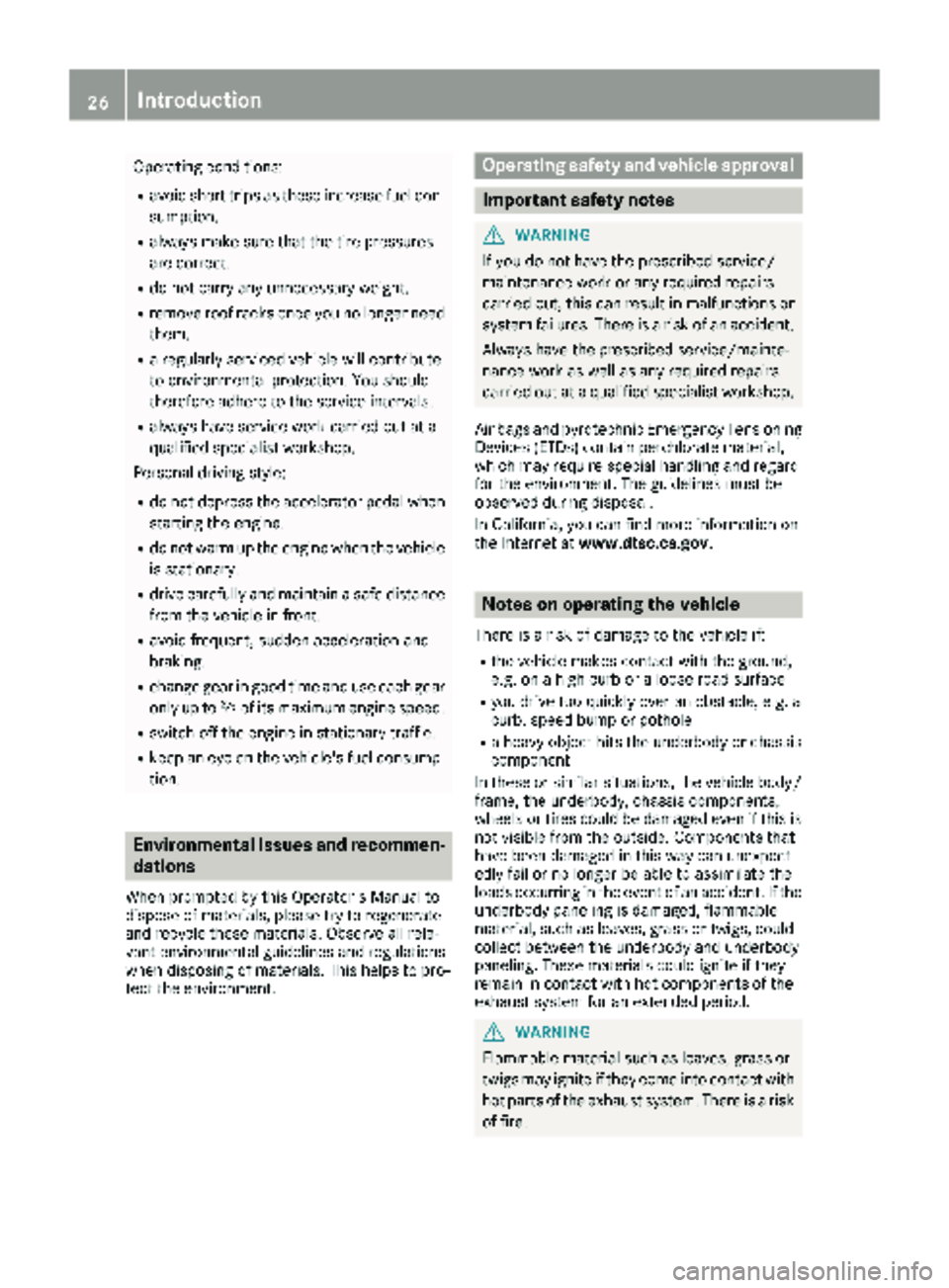
Operating conditions:
Ravoid short trips as these increase fuel con-
sumption.
Ralways make sure that the tire pressures
are correct.
Rdo not carry any unnecessary weight.
Rremove roof racks once you no longer need
them.
Ra regularly serviced vehicle will contribute
to environmental protection. You should
therefore adhere to the service intervals.
Ralways have service work carried out at a
qualified specialist workshop.
Personal driving style:
Rdo not depress the accelerator pedal when
starting the engine.
Rdo not warm up the engine when the vehicle
is stationary.
Rdrive carefully and maintain a safe distance
from the vehicle in front.
Ravoid frequent, sudden acceleration and
braking.
Rchange gear in good time and use each gear
only up to Ôof its maximum engine speed.
Rswitch off the engine in stationary traffic.
Rkeep an eye on the vehicle's fuel consump-
tion.
Environmental issues and recommen-
dations
When prompted by this Operator's Manual to
dispose of materials, please try to regenerate
and recycle these materials. Observe all rele-
vant environmental guidelines and regulations
when disposing of materials. This helps to pro-
tect the environment.
Operating safety and vehicle approval
Important safety notes
GWARNING
If you do not have the prescribed service/
maintenance work or any required repairs
carried out, this can result in malfunctions or system failures. There is a risk of an accident.
Always have the prescribed service/mainte-
nance work as well as any required repairs
carried out at a qualified specialist workshop.
Air bags and pyrotechnic Emergency Tensioning
Devices (ETDs) contain perchlorate material,
which may require special handling and regard
for the environment. The guidelines must be
observed during disposal.
In California, you can find more information on
the Internet at www.dtsc.ca.gov.
Notes on operating the vehicle
There is a risk of damage to the vehicle if:
Rthe vehicle makes contact with the ground,
e.g. on a high curb or a loose road surface
Ryou drive too quickly over an obstacle, e.g. a
curb, speed bump or pothole
Ra heavy object hits the underbody or chassis
component
In these or similar situations, the vehicle body/
frame, the underbody, chassis components,
wheels or tires could be damaged even if this is
not visible from the outside. Components that
have been damaged in this way can unexpect-
edly fail or no longer be able to assimilate the
loads occurring in the event of an accident. If the underbody paneling is damaged, flammable
material, such as leaves, grass or twigs, could
collect between the underbody and underbody
paneling. These materials could ignite if they
remain in contact with hot components of the
exhaust system for an extended period.
GWARNING
Flammable material such as leaves, grass or
twigs may ignite if they come into contact with
hot parts of the exhaust system. There is a risk of fire.
26Introduction
Page 55 of 286
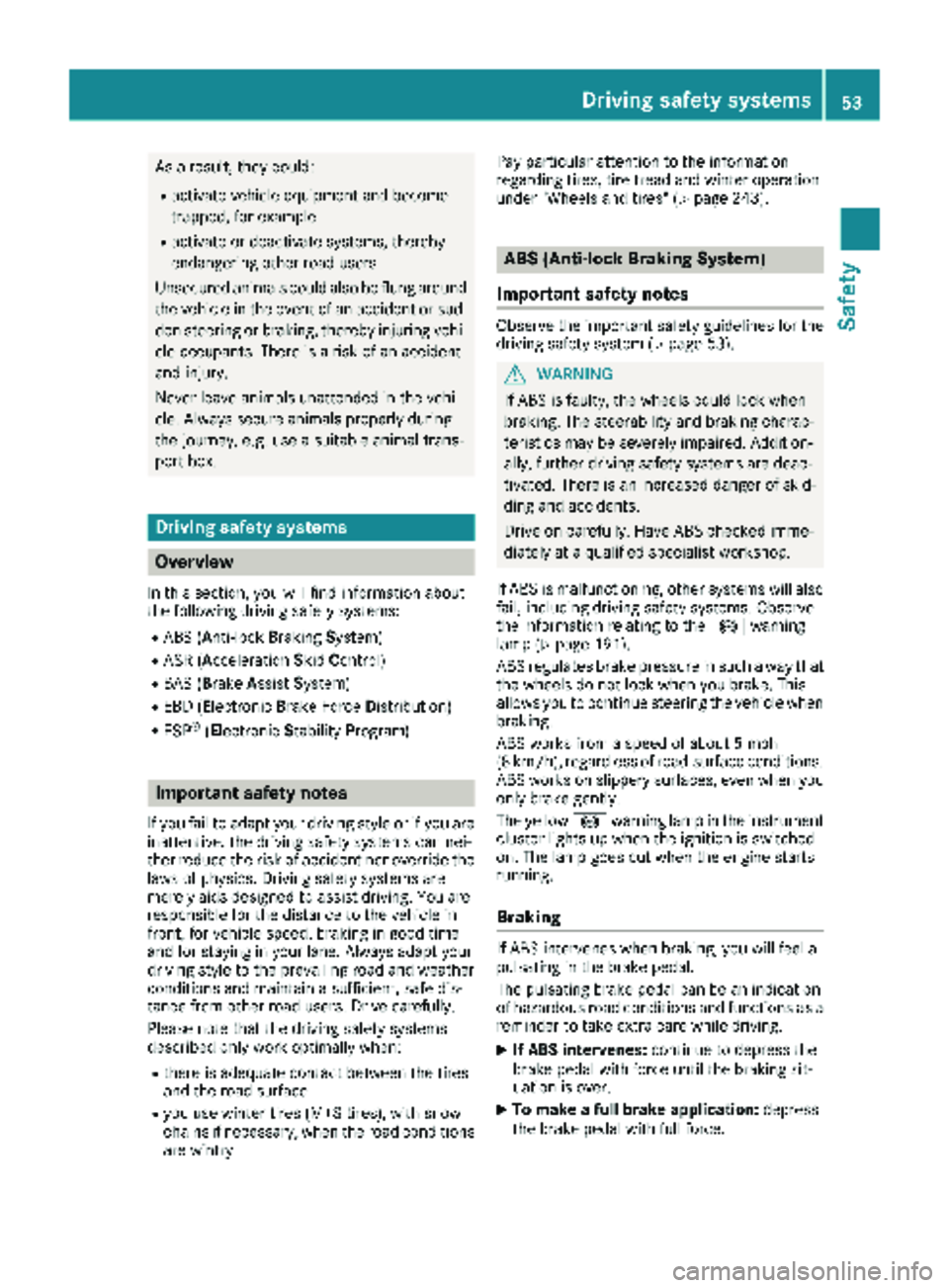
As a result, they could:
Ractivate vehicle equipment and become
trapped, for example
Ractivate or deactivate systems, thereby
endangering other road users
Unsecured animals could also be flung around
the vehicle in the event of an accident or sud-
den steering or braking, thereby injuring vehi- cle occupants. There is a risk of an accident
and injury.
Never leave animals unattended in the vehi-
cle. Always secure animals properly during
the journey, e.g. use a suitable animal trans-
port box.
Driving safety systems
Overview
In this section, you will find information about
the following driving safety systems:
RABS ( Anti-lock Braking System)
RASR (Acceleration SkidControl)
RBAS ( Brake Assist System)
REBD ( Electronic Brake Force Distribution)
RESP®(E lectronic StabilityProgram)
Important safety notes
If you fail to adapt your driving style or if you are
inattentive, the driving safety systems can nei-
ther reduce the risk of accident nor override the
laws of physics. Driving safety systems are
merely aids designed to assist driving. You are
responsible for the distance to the vehicle in
front, for vehicle speed, braking in good time
and for staying in your lane. Always adapt your
driving style to the prevailing road and weather
conditions and maintain a sufficient, safe dis-
tance from other road users. Drive carefully.
Please note that the driving safety systems
described only work optimally when:
Rthere is adequate contact between the tires
and the road surface
Ryou use winter tires (M+S tires), with snow
chains if necessary, when the road conditions
are wintry Pay particular attention to the information
regarding tires, tire tread and winter operation
under "Wheels and tires" (
Ypage 243).
ABS (Anti-lock Braking System)
Important safety notes
Observe the important safety guidelines for the
driving safety system (Ypage 53).
GWARNING
If ABS is faulty, the wheels could lock when
braking. The steerability and braking charac-
teristics may be severely impaired. Addition-
ally, further driving safety systems are deac-
tivated. There is an increased danger of skid-
ding and accidents.
Drive on carefully. Have ABS checked imme-
diately at a qualified specialist workshop.
If ABS is malfunctioning, other systems will also
fail, including driving safety systems. Observe
the information relating to the !warning
lamp (
Ypage 191).
ABS regulates brake pressure in such a way that
the wheels do not lock when you brake. This
allows you to continue steering the vehicle when
braking.
ABS works from a speed of about 5 mph
(8 km/h), regardless of road-surface conditions. ABS works on slippery surfaces, even when you
only brake gently.
The yellow !warning lamp in the instrument
cluster lights up when the ignition is switched
on. The lamp goes out when the engine starts
running.
Braking
If ABS intervenes when braking, you will feel a
pulsating in the brake pedal.
The pulsating brake pedal can be an indication
of hazardous road conditions and functions as a
reminder to take extra care while driving.
XIf ABS intervenes: continue to depress the
brake pedal with force until the braking sit-
uation is over.
XTo make a full brake application: depress
the brake pedal with full force.
Driving safety systems53
Safety
Z
Page 57 of 286
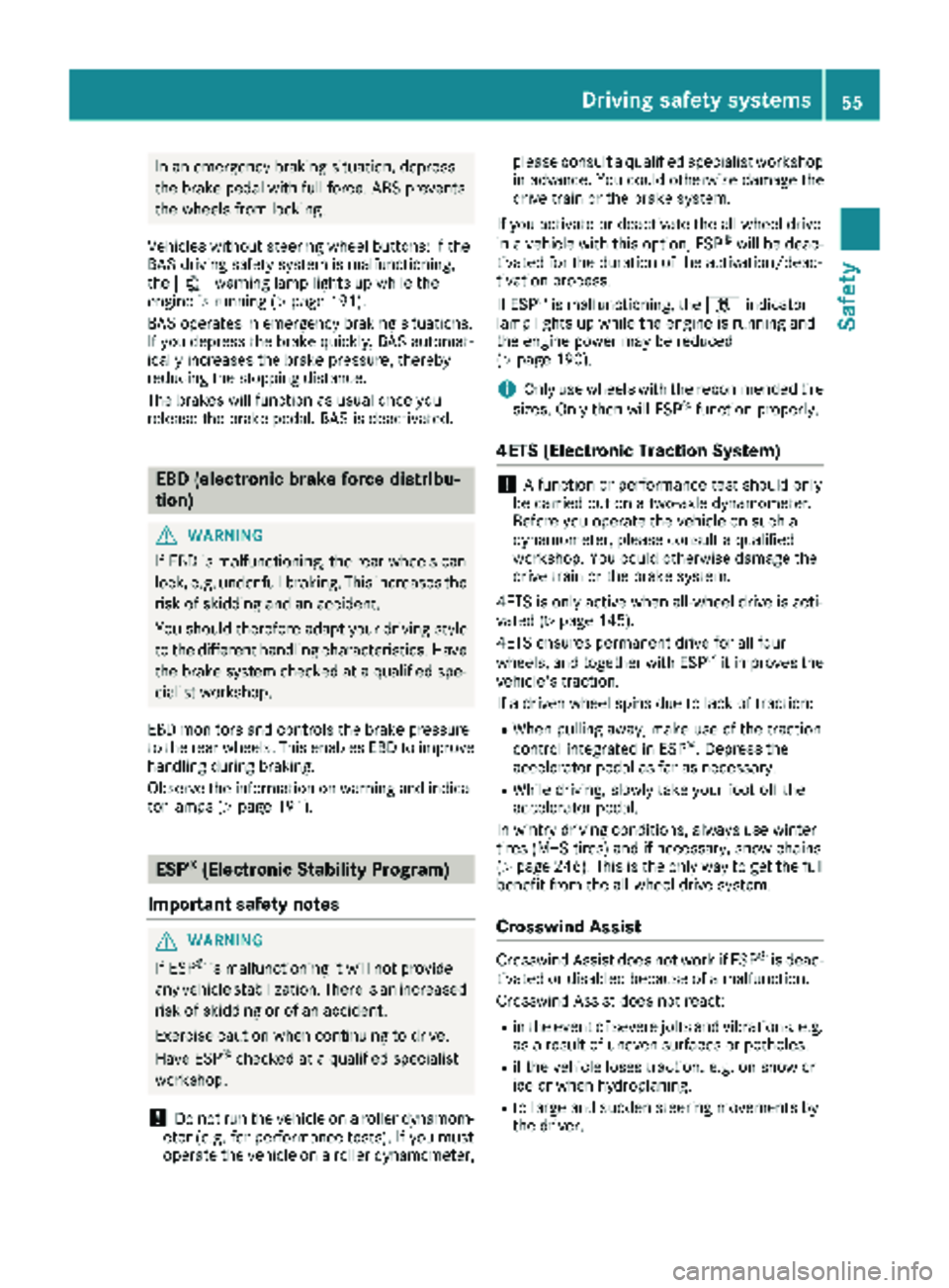
In an emergency braking situation, depress
the brake pedal with full force. ABS prevents
the wheels from locking.
Vehicles without steering wheel buttons: if the
BAS driving safety system is malfunctioning,
the : warning lamp lights up while the
engine is running (
Ypage 191).
BAS operates in emergency braking situations.
If you depress the brake quickly, BAS automat-
ically increases the brake pressure, thereby
reducing the stopping distance.
The brakes will function as usual once you
release the brake pedal. BAS is deactivated.
EBD (electronic brake force distribu-
tion)
GWARNING
If EBD is malfunctioning, the rear wheels can
lock, e.g. under full braking. This increases the
risk of skidding and an accident.
You should therefore adapt your driving style
to the different handling characteristics. Have
the brake system checked at a qualified spe-
cialist workshop.
EBD monitors and controls the brake pressure
to the rear wheels. This enables EBD to improve
handling during braking.
Observe the information on warning and indica-
tor lamps (
Ypage 191).
ESP®(Electronic Stability Program)
Important safety notes
GWARNING
If ESP
®is malfunctioning it will not provide
any vehicle stabilization. There is an increased
risk of skidding or of an accident.
Exercise caution when continuing to drive.
Have ESP
®checked at a qualified specialist
workshop.
!Do not run the vehicle on a roller dynamom-
eter (e.g. for performance tests). If you must
operate the vehicle on a roller dynamometer, please consult a qualified specialist workshop
in advance. You could otherwise damage the
drive train or the brake system.
If you activate or deactivate the all-wheel drive
in a vehicle with this option, ESP
®will be deac-
tivated for the duration of the activation/deac-
tivation process.
If ESP
®is malfunctioning, the hindicator
lamp lights up while the engine is running and
the engine power may be reduced
(
Ypage 190).
iOnly use wheels with the recommended tire
sizes. Only then will ESP®function properly.
4ETS (Electronic Traction System)
!A function or performance test should only
be carried out on a two-axle dynamometer.
Before you operate the vehicle on such a
dynamometer, please consult a qualified
workshop. You could otherwise damage the
drive train or the brake system.
4ETS is only active when all-wheel drive is acti-
vated (
Ypage 145).
4ETS ensures permanent drive for all four
wheels, and together with ESP
®it improves the
vehicle's traction.
If a driven wheel spins due to lack of traction:
RWhen pulling away, make use of the traction
control integrated in ESP®. Depress the
accelerator pedal as far as necessary.
RWhile driving, slowly take your foot off the
accelerator pedal.
In wintry driving conditions, always use winter
tires (M+S tires) and if necessary, snow chains
(
Ypage 246). This is the only way to get the full
benefit from the all-wheel drive system.
Crosswind Assist
Crosswind Assist does not work if ESP®is deac-
tivated or disabled because of a malfunction.
Crosswind Assist does not react:
Rin the event of severe jolts and vibrations, e.g.
as a result of uneven surfaces or potholes.
Rif the vehicle loses traction, e.g. on snow or
ice or when hydroplaning.
Rto large and sudden steering movements by
the driver.
Driving safety systems55
Safety
Z
Page 120 of 286

Preparing for a journey
Visual check of the vehicle exterior
XIn particular, check the following components
on the vehicle, and on the trailer as necessary:
Rlicense plates, vehicle lighting, turn signals,
brake lamps and wiper blades for dirt and
damage
Rtires and wheels for firm seating, correct
tire pressure and general condition
Rtrailer tow hitch for play and security
The trailer coupling is one of the most
important vehicle parts with regard to road safety. The separate instructions issued by
the manufacturer pertaining to operation,
care and maintenance should be observed.
Rthat contour markings on attachments and
bodies are in good condition
XRectify any noticeable defects before com-
mencing the journey.
Checks in the vehicle
Emergency equipment and first-aid kit
XCheck the equipment to make sure that it is
accessible, complete and ready for use.
The first aid and breakdown assistance equip-
ment is in the front door stowage compartments
and behind the driver's seat.
Vehicle lighting
XTurn the key to position 2in the ignition lock.
XCheck the lighting system with the aid of a
second person.
XReplace defective bulbs (Ypage 87).
Before driving off
GWARNING
Objects in the driver's footwell may restrict
the clearance around the pedals or block a
depressed pedal. This jeopardizes the oper-
ating and road safety of the vehicle. There is a risk of an accident.
Stow all objects securely in the vehicle so that
they do not get into the driver's footwell.
When using floormats or carpets, make sure
that they are properly secured so that they do
not slip or obstruct the pedals. Do not place
several floormats or carpets on top of one
another.
GWARNING
Unsuitable footwear can hinder correct usage of the pedals, e.g.:
Rshoes with thick soles
Rshoes with high heels
Rslippers
There is a risk of an accident.
Wear suitable footwear to ensure correct
usage of the pedals.
XSecure the load as per the loading guidelines
(Ypage 208).
XStow luggage items securely. Secure the load
as per the loading guidelines (Ypage 208).
XMake sure that the floormats and carpets are
properly secured so that they cannot slip and
obstruct the pedals.
XClose all doors.
Starting the engine
GWARNING
Combustion engines emit poisonous exhaust
gases such as carbon monoxide. Inhaling
these exhaust gases leads to poisoning. There
is a risk of fatal injury. Therefore never leave
the engine running in enclosed spaces with-
out sufficient ventilation.
!Do not depress the accelerator pedal when
starting the engine.
XBefore starting the engine, make sure that:
Rall the doors are closed.
Rall the vehicle occupants are wearing their
seat belts correctly.
Rthe parking brake is applied.
iIf you depress the brake pedal before start-
ing the engine, the pedal travel is short and
pedal resistance is high.
If you depress the brake pedal again after
starting the engine, pedal travel and resist-
ance will be back to normal again.
118Driving
Driving and parking
Page 132 of 286
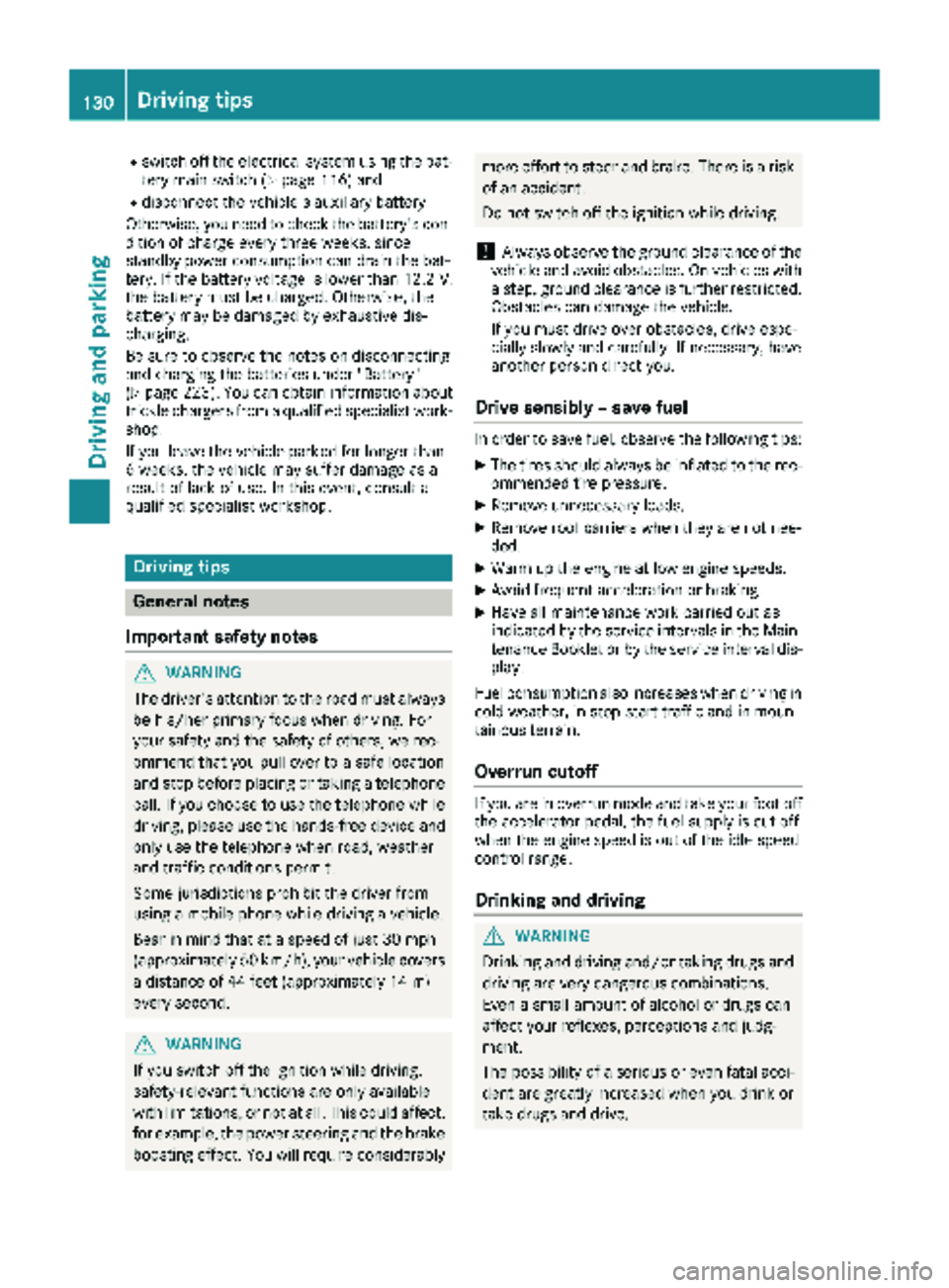
Rswitch off the electrical system using the bat-
tery main switch (Ypage 116) and
Rdisconnect the vehicle's auxiliary battery
Otherwise, you need to check the battery's con- dition of charge every three weeks, since
standby power consumption can drain the bat-
tery. If the battery voltage is lower than 12.2 V,
the battery must be charged. Otherwise, the
battery may be damaged by exhaustive dis-
charging.
Be sure to observe the notes on disconnecting
and charging the batteries under "Battery"
(
Ypage 223). You can obtain information about
trickle chargers from a qualified specialist work- shop.
If you leave the vehicle parked for longer than
6 weeks, the vehicle may suffer damage as a
result of lack of use. In this event, consult a
qualified specialist workshop.
Driving tips
General notes
Important safety notes
GWARNING
The driver's attention to the road must always be his/her primary focus when driving. For
your safety and the safety of others, we rec-
ommend that you pull over to a safe location
and stop before placing or taking a telephone
call. If you choose to use the telephone while
driving, please use the hands-free device and
only use the telephone when road, weather
and traffic conditions permit.
Some jurisdictions prohibit the driver from
using a mobile phone while driving a vehicle.
Bear in mind that at a speed of just 30 mph
(approximately 50 km/h), your vehicle covers
a distance of 44 feet (approximately 14 m)
ever yse cond.
GWARNING
If you switch off the ignition while driving,
safety-relevant functions are only available
with limitations, or not at all. This could affect, for example, the power steering and the brake
boosting effect. You will require considerably
more effort to steer and brake. There is a risk
of an accident.
Do not switch off the ignition while driving.
!Always observe the ground clearance of the
vehicle and avoid obstacles. On vehicles with a step, ground clearance is further restricted.
Obstacles can damage the vehicle.
If you must drive over obstacles, drive espe-
cially slowly and carefully. If necessary, have
another person direct you.
Drive sensibly – save fuel
In order to save fuel, observe the following tips:
XThe tires should always be inflated to the rec-
ommended tire pressure.
XRemove unnecessary loads.
XRemove roof carriers when they are not nee-
ded.
XWarm up the engine at low engine speeds.
XAvoid frequent acceleration or braking.
XHave all maintenance work carried out as
indicated by the service intervals in the Main-
tenance Booklet or by the service interval dis-
play.
Fuel consumption also increases when driving in cold weather, in stop-start traffic and in moun-
tainous terrain.
Overrun cutoff
If you are in overrun mode and take your foot off
the accelerator pedal, the fuel supply is cut off
when the engine speed is out of the idle speed
control range.
Drinking and driving
GWARNING
Drinking and driving and/or taking drugs and driving are very dangerous combinations.
Even a small amount of alcohol or drugs can
affect your reflexes, perceptions and judg-
ment.
The possibility of a serious or even fatal acci-
dent are greatly increased when you drink or
take drugs and drive.
130Driving tips
Driving and parking